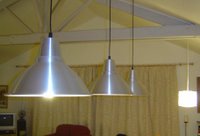
14th, Valentine’s Day, Saint Valentin here, was a wet one, and so a time to pick out some inside jobs off the long list of things to do. The lighting in our combined kitchen/living room was by way of many small halogen lights. They give a lovely quality of light and don’t seem to be too greedy energy-wise, just 20 watts a bulb, but with two rows of five, and three more powerful ones lighting the other half of the room, the total for the room was an astonishing 450W! It annoyed me almost every time we turned them on and especially when they got left on by mistake. On a recent trip to IKEA (a decently-priced Swedish home ware store) we bought several lamps and low-energy bulbs to go with them.
If permaculture is anything, then it’s a design system. Whilst Gabrielle's design skills in selecting cheap, stylish, funky and functional lighting might not quite fit the definition of permaculture design per se, the end effect certainly was: we’ve replaced 450W with just 73W and, to be honest, it’s brighter where it matters.

Valentine's Day is also a day to be romantic and I’d put Gabrielle off the scent by being all blokey and uninterested the day before but came up trumps on the day by bringing her tea in bed with flowers and a card. Her present to me was a runcible spoon! The word was invented by Edward Lear in his whimsical verse, The Owl and the Pussycat and then took on a life of its own and now refers to a cross between a fork and a spoon, particularly useful in consuming fruit, I assume.
The Owl and the Pussy-Cat went to sea
In a beautiful pea-green boat:
They took some honey,
and plenty of money
Wrapped up in a five-pound note.
……(several verses later)
"Dear Pig, are you willing to sell for one shilling
Your ring?" Said the Piggy, "I will."
So they took it away, and were married next day
By the Turkey who lives on the hill.
They dined on mince and slices of quince,
Which they ate with a runcible spoon; and so it continues…

Quinces are inedible raw but apparently delicious and aromatic when cooked. They’re originally from Persia and Turkestan and still much grown in many parts of Europe. Their pulp makes Dulce de Membrillo or Marmelo, the origin of the marmalade we now make from citrus fruit. Quince trivia courtesy of Bob Flowerdew’s excellent Complete Fruit Book p.32. Now I’ve got a “genuine” runcible spoon, I suppose we ought to think about buying a quince tree!
I’m off to the woods with my chainsaw today, so in my next blog I’ll give you a full update of our permaculture design for our woodland.
